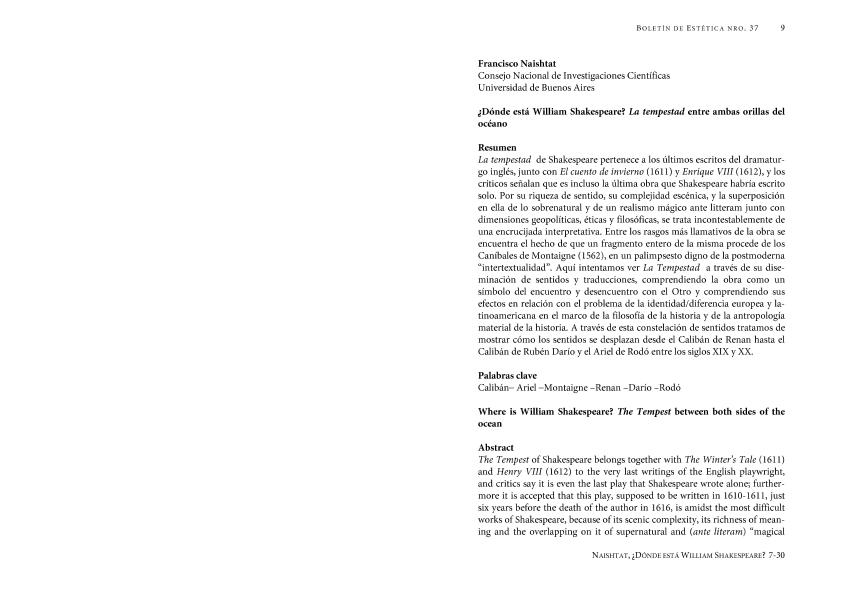Mostrar el registro sencillo del ítem
dc.contributor.author
Naishtat, Francisco

dc.date.available
2022-11-30T12:57:06Z
dc.date.issued
2016-12
dc.identifier.citation
Naishtat, Francisco; ¿Dónde está William Shakespeare?: "La Tempestad" entre ambas orillas del océano; Centro de Investigaciones Filosóficas. Instituto de Filosofia “Ezequiel de Olaso". Programa de Estetica y Filosofía del Arte; Boletín de Estética; 37; 12-2016; 7-30
dc.identifier.issn
2408-4417
dc.identifier.uri
http://hdl.handle.net/11336/179504
dc.description.abstract
La tempestad de Shakespeare pertenece a los últimos escritos del dramaturgo inglés, junto con El cuento de invierno (1611) y Enrique VIII (1612), y los críticos señalan que es incluso la última obra que Shakespeare habría escrito solo. Por su riqueza de sentido, su complejidad escénica, y la superposición en ella de lo sobrenatural y de un realismo mágico ante litteram junto con dimensiones geopolíticas, éticas y filosóficas, se trata incontestablemente de una encrucijada interpretativa. Entre los rasgos más llamativos de la obra se encuentra el hecho de que un fragmento entero de la misma procede de los Caníbales de Montaigne (1562), en un palimpsesto digno de la postmoderna “intertextualidad”. Aquí intentamos ver La Tempestad a través de su diseminación de sentidos y traducciones, comprendiendo la obra como un símbolo del encuentro y desencuentro con el Otro y comprendiendo sus efectos en relación con el problema de la identidad/diferencia europea y latinoamericana en el marco de la filosofía de la historia y de la antropología material de la historia. A través de esta constelación de sentidos tratamos de mostrar cómo los sentidos se desplazan desde el Calibán de Renan hasta el Calibán de Rubén Darío y el Ariel de Rodó entre los siglos XIX y XX.
dc.description.abstract
The Tempest of Shakespeare belongs together with The Winter’s Tale (1611) and Henry VIII (1612) to the very last writings of the English playwright, and critics say it is even the last play that Shakespeare wrote alone; furthermore it is accepted that this play, supposed to be written in 1610-1611, just six years before the death of the author in 1616, is amidst the most difficult works of Shakespeare, because of its scenic complexity, its richness of meaning and the overlapping on it of supernatural and (ante literam) “magical realism”, together with geopolitical, ethical and philosophical dimensions. Among the most crucial philosophical points here is the incontestable fact that certain sentences of the play are literally taken from the Essays of Michel de Montaigne, and precisely from Des Cannibales, which is the chapter XXX of the Essays (1562), giving a palimpsest which would be familiar in nowadays “intertextuality”. We try here to see The Tempest of Shakespeare through its dissemination of meaning in translations and resemantisations, understanding this play as a symbol of the encounter and misencounter with the Other, and seeing its effects in connection with the problem of Latin- American and European difference and identity, in the frame both of philosophy of history and of material anthropology of history. Through this constellation of meaning we try to show how the meanings cross the ocean since Renan’s Caliban (1878) to Dario’s Caliban (1898) and to Rodo’s Ariel (1900) from Europe to Latin America and return.
dc.format
application/pdf
dc.language.iso
spa
dc.publisher
Centro de Investigaciones Filosóficas. Instituto de Filosofia “Ezequiel de Olaso". Programa de Estetica y Filosofía del Arte
dc.rights
info:eu-repo/semantics/openAccess
dc.rights.uri
https://creativecommons.org/licenses/by/2.5/ar/
dc.subject
CALIBAN
dc.subject
POSTCOLONIAL
dc.subject
SHAKESPEARE
dc.subject
RENAN
dc.subject.classification
Filosofía, Historia y Filosofía de la Ciencia y la Tecnología

dc.subject.classification
Filosofía, Ética y Religión

dc.subject.classification
HUMANIDADES

dc.title
¿Dónde está William Shakespeare?: "La Tempestad" entre ambas orillas del océano
dc.title
Where is William Shakespeare?: The Tempest between both sides of the ocean
dc.type
info:eu-repo/semantics/article
dc.type
info:ar-repo/semantics/artículo
dc.type
info:eu-repo/semantics/publishedVersion
dc.date.updated
2022-11-29T13:10:19Z
dc.journal.number
37
dc.journal.pagination
7-30
dc.journal.pais
Argentina

dc.journal.ciudad
Ciudad Autónoma de Buenos Aires
dc.description.fil
Fil: Naishtat, Francisco. Consejo Nacional de Investigaciones Científicas y Técnicas; Argentina. Universidad de Buenos Aires. Facultad de Ciencias Sociales. Instituto de Investigaciones "Gino Germani"; Argentina. Universidad Nacional de La Plata; Argentina
dc.journal.title
Boletín de Estética
dc.relation.alternativeid
info:eu-repo/semantics/altIdentifier/url/https://boletindeestetica.com.ar/index.php/boletin/article/view/65
Archivos asociados
